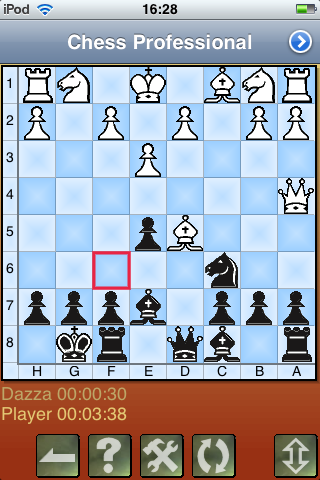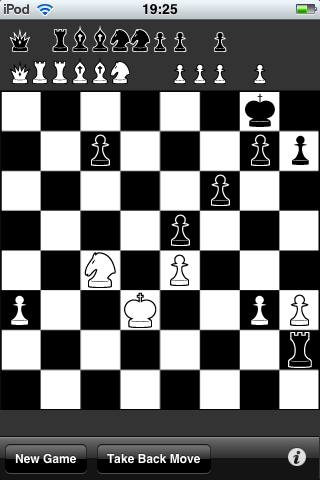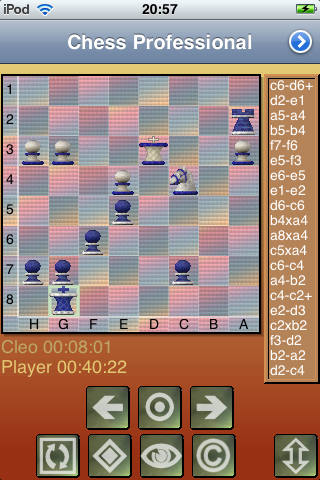It all started when the John at ZingMagic, creator of Chess Professional for every other handheld platform since time began, buzzed me that Chess was now available in the iPhone App Store. I used ‘Search’ to find it and discovered another dozen versions of Chess at the same time. Wow. Talk about competition!
Hmm…. One way to rate how good or bad Chess Professional and the other chess applicatons really are would be to play them all using my legendarily bad chess skills. But a more reliable way would be to pit them against each other. Now, admittedly, in this piece I’m only pitting the newcomer against an identically-priced competitor ($1), but it’s still a valid and interesting test.
What I’m doing is using the fact that Chess Professional lets me play as ‘black’, inputting the moves made by the AI engine in iChess, and then feeding back Chess Professional’s moves into iChess for its response, and so on. In other words, the two chess games play each other.
I set iChess to ‘Difficult’ mode (its maximum), in which mode it thinks for up to 3 seconds, while Chess Professional was set to ‘Expert’ (its maximum), although it tended to think for upwards of 10 seconds, in theory giving it an edge.
As with all computer-computer chess games, there was a mix of boring to-and-fro, interchanged with frantic piece exchanges and with little overall thought to positional strategy.
However, after an hour of playing time (much of which was my noticing the moves made and exiting the game in order to start the other and input them!), iChess manages a couple of nice multi-move combos that ended in forks and gained it a piece advantage. At the point shown below, iChess (black) had more pawns and a more mobile main piece. It started picking off the remaining white pawns and I then resigned on the behalf of Chess Professional.
So, despite the greater thinking time, the newcomer proved itself the less able chess player – just. There wasn’t a huge amount of difference. In terms of interface, iChess is functional and static, with few options, although I did like the way captured pieces were matched up along the top of the screen.
In contrast, Chess Professional has five different chess sets, a variety of funky board colourings and a dozen or so possible screen layouts, including one where every move made in the game is listed. My only complaint would be that the control icons at the bottom of the screen aren’t very descriptive and that there’s a distinct learning curve while you push them, spot what they do and then try and remember for next time(!)
But at only $1 each, for all chess fans, both games are an absolute snip.
NB. The Chess Professional price is an introductory offer – so strike quickly!



